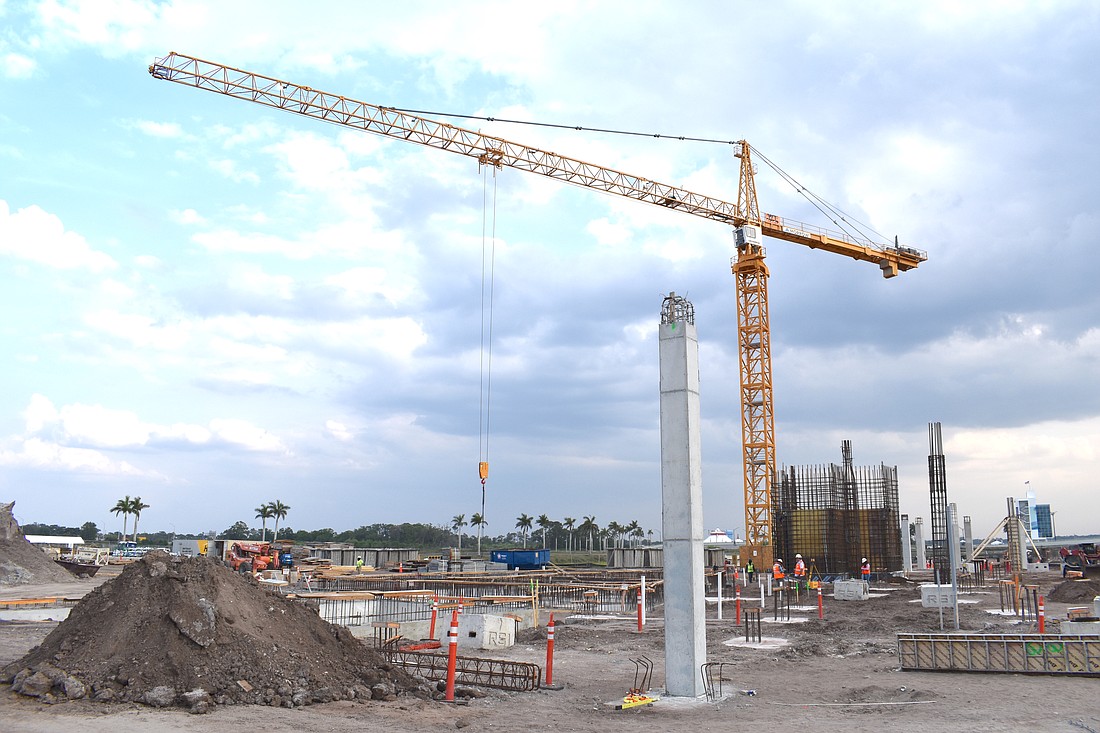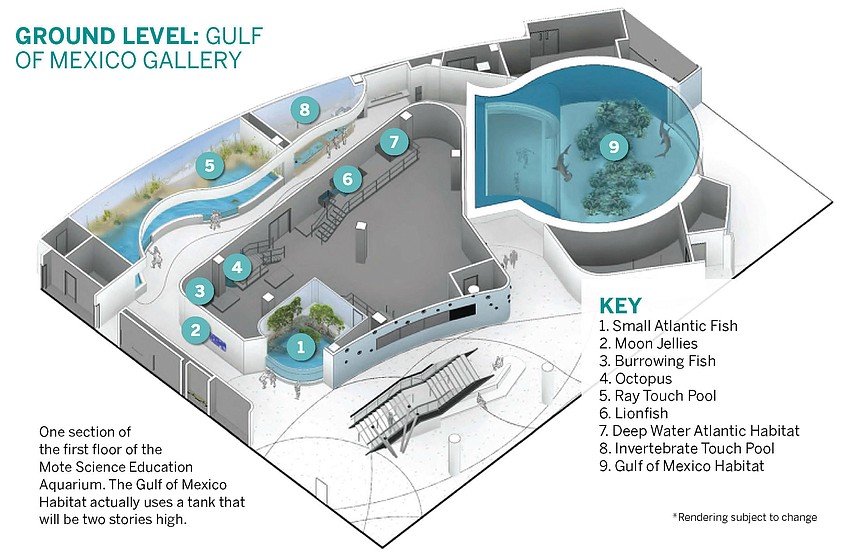- July 11, 2025
-
-
Loading

Loading

Dan Bebak, vice president at Mote Marine Laboratory and Aquarium, stepped outside his construction trailer, and headed toward the construction site for the new Mote Science Education Aquarium that sits adjacent to Nathan Benderson Park in Sarasota.
As he drove toward the site, he continually looked up.
Yes, up.
Up is a celebratory word for Mote because it means its $130 million project (now a $132 million project) that was announced in February 2018 and broke ground in November 2020, has begun to make a visual impact on anyone who passes.
That's a massive impact considering more than 50 million vehicles pass the 11.76-acre parcel along Interstate 75 in a year.
Besides the busy workers on the ground level, two huge cranes are on site, moving around building materials set to go skyward. Columns and elevator shafts already have stretched toward the sky and in May, the huge Gulf of Mexico acrylic windows, that help form a tank that occupies both the first and second floors of the three-story, 110,000-square-foot building, will be placed.
Because that Gulf of Mexico exhibition tank is so massive, builders Willis Smith Construction and Whiting-Turner will have to place it before they can begin to construct the walls around it. That's when the vertical construction takes off.
"Once you get vertical, (funding) picks up," said Michael Moore, special advisor to the office of the president at Mote. "Up to that point, you have to be a visionary. Now the public is feeling the vibe."
Moore said Mote has a commitment of $100 million toward the aquarium with "a couple" other large potential donors seriously considering to come on board.
But he said the vertical stage of any project often stimulates corporate sponsorships most.
"Corporate sponsorship is the last in," he said. "They want to get closer to get real. Now it's really happening."

Bebak began working at Mote in 1981 as an intern and was permanently hired in 1985, eventually working his way up the ladder to overseeing a $7 million annual budget and a staff of 70.
"It's great to actually walk out there," he said of the construction site. "And it's going to be nice to say, 'There's the Gulf of Mexico tank.'"
The two acrylic "windows" that make up the Gulf of Mexico exhibition tank weigh a combined 14 tons. That will be a sight in itself (although the acrylic will be covered by plywood) as those passing by will see the tank being constructed in May and June. The windows are being shipped from Reynolds Polymer Technology in Grand Junction, Colorado.
Then it's off to the races.

As the project goes skyward, work on the second and third floors will be mostly complete before the first-story floor is completed. Bebak said heavy materials, such as the tanks, must be brought into the first floor, which would ruin the flooring.
While people think about vertical construction being from the ground up, Bebak noted the 368 pilings that have been put into place to support the construction are, indeed, vertical, with the pilings going 80 to 90 feet into the ground.
So far, Mote has spent about $30 million on site and below-the-ground construction.
"We are on schedule and looking at the fall of 2024 to open," Bebak said. "Now that we are going vertical, we know what we have ahead of us. We will put the water in the tanks and get the fish in there. We will still be doing finishing work when we do that."
The tanks will be complete with wildlife months before the doors open to the public in fall 2024. The wildlife needs time to become acclimated. Mostly natural sea water will be used to fill the tanks.
"We will have a better idea of opening dates in a couple of months," Bebak said. "And you never know what the weather is going to do."
Half of the third level of the aquarium will be open air. That will give patrons an indoor-outdoor experience.
Moore said successful planning has allowed the project to stay mostly within its budget during a time of extreme inflation. The original $130 million price tag had some inflation figured into it, but Moore said Mote had been buying materials for more than three years and had been locking in prices.
"We are not seeing that escalation (in budget)," Moore said.
Bebak noted the construction project is highly specialized because almost every part of the aquarium has life support systems and specialized pumps, filters, plumbing, air conditioning and heating systems.
All the support systems, such as columns, must be extraordinarily strong. For instance, the Florida Waters Gallery tank on the third floor will hold 300,000 gallons of water.
"You need a lot more rebar," Bebak said.
All that has been taken into account.
"The project is moving," Bebak said. "Nothing is going to stop us, except some weather here and there."
Mote estimates the aquarium will draw 600,000 to 700,000 visitors in its first year.